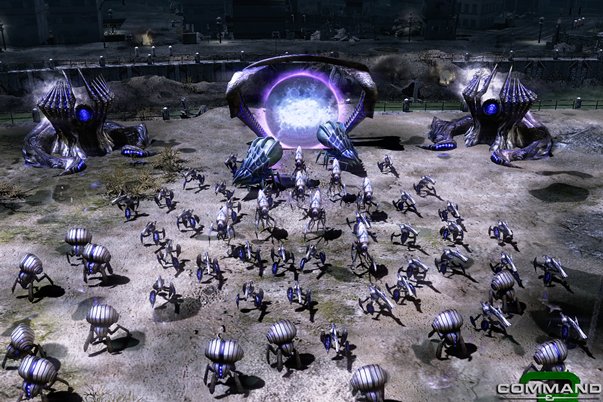Command & Conquer 3 - mega interview
As the Tiberium Wars begin, the game's developers tell you how to prepare and what to expect next
GamesRadar: What went into developing a third faction? How do they play differently from GDI and Nod?
MV: GDI is a steamroller - they build tanks, infantry, aircraft. It's all about a brute force assault. Nod is a finesse side, using hit-and-run tactics and stealth. It's very fast and you want to micro-manage your units more than you do when you're playing GDI.
The aliens have a bit of a mixed personality. It's our chance to bring a new style of play into Command & Conquer. They start with some weaker units, but as you build up into the higher units and tech up, you can bring out some amazing big guns. You've got city-destroying mother ships, huge tripods with independently targeted beam weapons, flying artillery ships and carriers that have swarms of fighters around them. Survive long enough and a Scrin player can dominate.

JB: The Scrin were a real challenge because we wanted to make them play very differently. They're an alien invasion force, here to accomplish something. They're constructors. They want to build up their technology and certain devices. They're not simply set on wiping out whatever life was on the planet. They have a different objective and have had to repurpose their equipment to fight us.
Aliens can be anything, but we wanted to create aliens that would fit into this world and still be able to fight toe-to-toe with Nod and GDI without just overwhelming them completely. The way their units are created factors into that.
In the early game, they have their own personality and very different infantry units. In the mid-game, they fall behind a little bit. They have some amazing tanks, but Nod has all the stealth and GDI has all the armor, so they tend to get a little weak in multiplayer. But then in the endgame, they have all these super weapons, space ships and massive crazy alien technology.
Sign up to the GamesRadar+ Newsletter
Weekly digests, tales from the communities you love, and more
GamesRadar: What's your favorite super weapon?
JB: My favorite super weapon is the new Scrin one. They have the ability to generate a black hole somewhere on the battlefield that just sucks everything up and sends it out into space. As it unfolds, you can see actual stars and nebulas in it. I think that's a lot of fun.
JB: The Scrin were a real challenge because we wanted to make them play very differently. They're an alien invasion force, here to accomplish something. They're constructors. They want to build up their technology and certain devices. They're not simply set on wiping out whatever life was on the planet. They have a different objective and have had to repurpose their equipment to fight us.
Aliens can be anything, but we wanted to create aliens that would fit into this world and still be able to fight toe-to-toe with Nod and GDI without just overwhelming them completely. The way their units are created factors into that.
In the early game, they have their own personality and very different infantry units. In the mid-game, they fall behind a little bit. They have some amazing tanks, but Nod has all the stealth and GDI has all the armor, so they tend to get a little weak in multiplayer. But then in the endgame, they have all these super weapons, space ships and massive crazy alien technology.
GamesRadar: What's your favorite super weapon?
JB: My favorite super weapon is the new Scrin one. They have the ability to generate a black hole somewhere on the battlefield that just sucks everything up and sends it out into space. As it unfolds, you can see actual stars and nebulas in it. I think that's a lot of fun.



